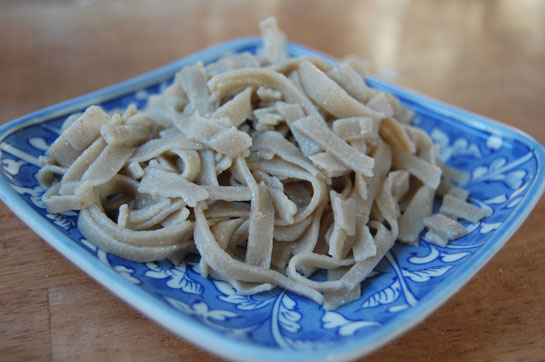
Did you know that you can make your own buckwheat soba noodles? We found that homemade buckwheat noodles taste twice as good as the 100 percent buckwheat soba noodles we’ve bought before, and cost half as much. Mild, tender, and delicious, they are the perfect foundation for a beautiful pasta dish, and you can even serve them to a gluten free guest!
I choose to make these buckwheat noodles out of 100 % buckwheat, so they are completely gluten free. Buckwheat, by the way, is not at all related to wheat. It’s not even considered a “grain”, but rather is a highly nutritious “seed”.
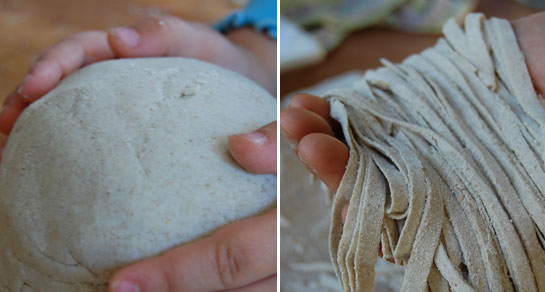
“While many people think that buckwheat is a cereal grain, it is actually a fruit seed that is related to rhubarb and sorrel making it a suitable substitute for grains for people who are sensitive to wheat or other grains that contain protein glutens. Buckwheat flowers are very fragrant and are attractive to bees that use them to produce a special, strongly flavored, dark honey. ” WHfoods.com
But if you want to add a bit more strength to your pasta dough, you could add up to half whole wheat bread flour in place of some of the buckwheat flour, though obviously you wouldn’t want to then serve it to a gluten free guest!
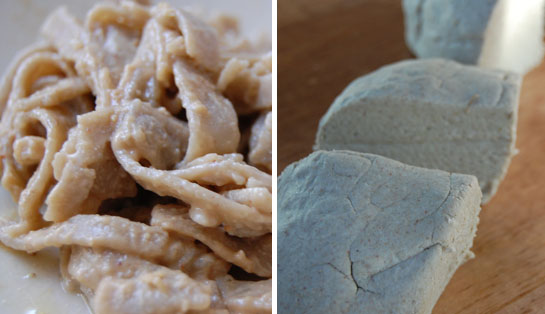
As it was, I was surprised at how easy it was to work with. I was imagining the dough being completely unworkable. But it holds together quite well!
Enjoy!
Homemade Buckwheat Soba Noodles
Makes 6 servings
This recipe uses the soaking method, which neutralizes anti-nutrients in grain, so start the night before.
2 cups of buckwheat flour *See notes above for adding in wheat flour for extra strength
1/2 cup of water
1/2 tablespoon raw apple cider vinegar or lemon juiceThe night before, place the flour in a medium size bowl. Pour the water and vinegar/lemon juice into the bowl and mix with a wooden spoon until you’ve combined it as much as you can. It will most likely be a crumbly mixture at this point. Using your hands, start kneading the mixture until the water and four starts turning into a ball (at which point you can knead a little on a clean surface outside the bowl). Knead for a few minutes until it forms into a firm ball. If needed, you can add 1-2 tablespoons of more water, or flour. You want a firm, but not dry, or wet ball. 1/2 cup of water to 2 cups of flour was perfect for me.
Clean out your bowl and place the dough ball back into it. Dampen a clean dish towel, and wring dry. Place over the ball of dough to keep it moist while it “soaks”. I also put plastic wrap over the bowl, just to make sure that everything stays moist. Leave the bowl out on the counter top overnight for 12 -24 hours.
When ready to roll out, first place a large pot of water to boil on the stove. While the Japanese don’t salt their pasta water, I like too, as the dough doesn’t contain any salt. So salt it generously.
Meanwhile, divide the dough into four sections. Using arrowroot powder, buckwheat flour, or even white flour (once again, only if you don’t have to be gluten free), flour the rolling surface well. If you have a large wooden cutting board, it’s nice to roll and cut directly on it. Flour the top of the dough and your wooden rolling pin. With gentle, but firm motions, start rolling out the dough. You want to roll it out to about 1/8 inch thickness or even thinner! During this process make sure that you are keep both sides of the dough well floured.
To make it easier to cut, I cut the dough into thirds (about 4 inches tall), and laid them on top of each other (just make sure they are lightly floured to prevent sticking).
Using a sharp knife, cut the noodles into 1/8 inch “slices” all the way down the dough.
Repeat this process with the rest of the dough and let the noodles rest for about 10-20 minutes.
Meanwhile, your pot of water should be ready. Make sure it’s at a rolling boil, then add all of the noodles at once, giving a gentle stir to make sure they don’t stick to each other. It should only take two minutes to cook. When done they should be tender, but still be slightly chewy.
Drain the noodles, making sure that you use a colander with fine holes so the noodles don’t fall through!
You can now rinse with cold water to cool them if you are using it in a cool dish, or keep warm for whatever dish you have planned for it.
Enjoy!
P.S. We used a peanut sauce from this recipe, which was wonderful when tossed with the buckwheat noodles.
Latest posts by KimiHarris (see all)
- 2 Ingredient Peppermint Bark - December 21, 2022
- Herbal Hibiscus Lemonade (Keto, THM) - March 16, 2022
- Creamy Curry Red Lentil Soup - December 8, 2021
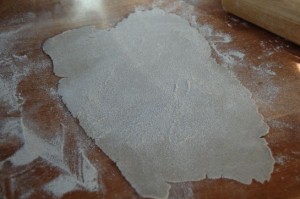
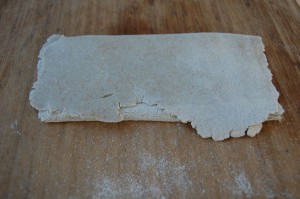
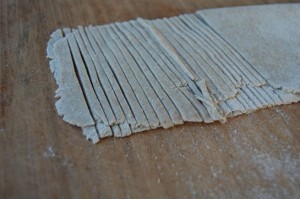
This looks very interesting! I want to try it, but am a bit confused on one point. You say to soak the grains overnight… I went and read your post about soaking grains, and I read through the recipe, but I’m still not quite sure how it’s done.
Is it at this point that I then leave it overnight?
Probably a really silly question, but I’m super new to all of this!
Daisy,
Oops! No wonder you were confused as I forgot to add the directions to leave it out on the table/countertop overnight. I added that part in. Hope that makes sense now!
Perfect. I have been wondering what to do with the gluten flour that someone gave me. I’d love to try these instead of the brown rice noodles I have been buying.
Kimi,
Do you think it would work kneading it in the bosch?
An FYI..I don’t see in the recipe where a person would add in the acidic base…I know when it should be added, but a new person to soaking may not understand…Jessica O.
I use my Bosch to make noodles all the time although I haven’t made these buckwheat noodles yet. If the buckwheat handles the same as wheat. This is what I do. I place all my flour in the bowl and I use the whisk beaters. I add the liquid a little at a time mixing quite a while between additions it takes quite a while for the moisture to be evenly mixed in. Leave the mixer running as you add the liquid. Watching your dough very closely. Once the mix resembles large peas bouncing around inside the bowl your done. Do not add anymore liquid. The dough will stick together when you use your hands. Knead it a couple of times on the counter top and wrap and handle as instructed above. Dough made this way will work perfectly in your extruder pasta maker that fits on the meat grinder.
Thank you so much for including a recipe using soaked gluten free flour! I just started reading Nourishing Traditions and soaking flours is very new to me, let alone gluten free flours.
Question: I noticed the cider vinegar was not mentioned in the recipe, is this added with water when soaking? Also, can the noodles be frozen for later use before cooked?
My favorite way to use buckwheat noodles is in a warm pot of miso soup cooked with carrots, garlic, ginger, and bok choy, yum!
I’m warming up your crockpot chicken quinoa for lunch now! Thanks again for providing this fantastic website!
Stephanie
Wow! That is amazing. I have never attempted to make noodles before. I think it would be a fun project to do with my daughter(13) who is a pretty good cook:) I just want to tell you too how much I love your blog!
Oh, I forgot–I left a comment on your post with the walnut cookies. I was asking your opinion of agave, but I think I was too late for you to see it. I have been hearing that agave is no better than HFCS. Just wondering what your thoughts are about it. Thanks:)
Kimi,
Those look really good! I love buckwheat and it is an awsome source of niacin amoungst other things, but I find it curious that people with blood type-B are sensitive to buckwheat as it forms dangerous blood lectins. Did your noodles loose a lot of starch into the water while boiling? I heard you can temper by adding a half a cup of cold water just as the noodles begin to boil and reapeat several times till done. Mabey worth a try?
Hi Kimmi……I have a pasta roller. Do you think these noodles will make it through the rollers?
Jessica and Stephanie,
Thank you both for pointing that out! You add it with the water, I just left it out, Oops, again! I will go add it in now. Thanks!
Kimberly,
Thanks so much for the sweet comments. And thank you for re-asking your question! Please, everyone, feel free to do that, as a question often gets “lost” on my blog as I get too many to keep track of them now! Agave Syrup, I used to use it (and you will find it in some of my recipes on this blog), but no longer do as Sally Fallon, author of Nourishing Traditions, has many concerns with it. I will say that it didn’t bother a yeast issue I used to deal with, but because of other concerns (like it being bad for my liver), I don’t use it anymore. I like to use honey instead now.
Carole,
I’ve never used a pasta roller, so I couldn’t say for sure. Do be aware that if you don’t add any wheat flour to this recipe, it will be more delicate and tear much more easily. But it’s worth a try. 🙂
(By the way, I’ve heard from others who use both that it’s not necessarily any faster using a pasta roller! Just something to consider. 🙂 ).
Great post! I was just mourning that fact that my store no longer carries soba noodles. I really didn’t even think to make my own. Now I know what to do with that buckwheat flour I have stored in the fridge!
Wow, Kimi, these look terrific! I definitely want to try these soon. 🙂
Thanks so much, 🙂
Shirley
Kimi,
Thank you so mush for posting this! I’ve been checking every single japanese grocery store in my area for wheat free soba noodles without any success!
Now do you have a link regarding agave syrup being bad for the liver?
I have a sensitive liver due to many years of hypoglycemia yet I’m trying to keep my “sugar” intakes low which seems to work fine so far (I read a few hours ago that it’s best to eat fatty foods/meats since fats break down into glucose).
I love honey but it has a fairly high GI and doesn’t seem to help my teeth.
Which natural sweetener do you think is best/healthier for cooking/baking?
Thanks ;).
Wow! Thanks so much for the recipe, I will definately try these!
My husband and daughter have made noodles with spelt berries for many years. They actually grind the berries into flour and make the noodles!
I’ll show them your recipe for buckwheat noodles. Hopefully we’ll have fresh buckwheat noodles soon.
Thank you for the recipe.
Thank you for posting this recipe! I love soba noodles in miso and various other asian-style dishes. Do you know if these freeze well or dry well? I like to keep things on hand that can be made up for a quick snack or dinner. We have teenage boys who are always looking for something to eat. They are very active and I don’t want them filling up on junk!
Kimi,
Do you think these would kneed ok in the bosch?
Jessica
How cool! I never knew anything about soba noodles or buckwheat having never had them and would love to try it now using this recipe.
Thank you for teaching me so much about buckwheat. I found the information quite interesting and am amazed at how nutritious and healthy it is.
Have a blessed day ;o)
Alchemelle,
I believe I read that either on cheeseslave.com or kellythekitchenkop.com. I believe the idea is that excess fructose is hard on the liver because it has to process it. But don’t quote me on that, as I am am not positive I am relaying it right. 🙂 I use coconut sugar, which is a traditional sweetener (unlike agave), and has a very similar glycemic index like agave. We love the taste too.
One interesting thing to keep in mind is that everyone does respond to sugars differently. Some people don have a “sugar spike” from even white sugar (that doesn’t mean that it’s good for them to have, just that their body handles it differently). I read that in Nourishing Traditions. So I think everyone does have to see what works well for them.
Hope that helps!
Do you know if these will freeze or dry well? Also where do you get your water kefir grains? I’ve not been able to find them in our area of Alaska.
Thanks,
Peggy
Thanks again for this recipe. I wanted to make this but had quinoa and rice flour at home, so used them instead, adding a bit of regular flour, but otherwise following your recipe for the buckwheat noodles.They came out nice!
I made these a while back, and it give one a great appreciation for hand made foods! I love buckwheat, and your photos of the process rock!
Oh wonderful! I am going to make this with my girls. I have not been able to find gluten-free 100% buckwheat noodles and have searched everywhere. All of the labels say that they are processed in a facility that processes wheat. 🙁
I love buckwheat and can’t wait to try these out, thanks for posting!
-Ali 🙂
My first time visiting your site! I’ve been thinking about The Nourishing Gourmet for a few years as my possible business venture…. and that’s how I found your site! It’s quite a powerful name! I love what you are doing and sharing. Nourishing Traditions is one that I refer back to again and again as well. My gluten intolerance allows me to try different things and it’s fun to encounter hear about others creations. Thanks!
I was very excited to try these, but unfortunately, I couldn’t get the dough to hold together while I rolled them out. Fortunately, my 2 year-old didn’t seem to mind that they weren’t exactly “noodle” shaped. Any tips?
Hi Chari,
It’s always such a let down when a recipe doesn’t behave for you! It’s hard for me to know why it wasn’t holding together since I can’t touch/see/and knead your dough. (the real problem with blogging!). But here are a few things I thought of (by the way, when I make this, it is more fragile than my whole wheat pasta because of the lack of gluten, but as you can tell from the pictures, it holds together well enough to cut noodles from etc. If you can have gluten, adding some whole wheat flour in for part of the flour would help).
1-The night before, did it form into a firm ball? Depending on the weather and where you live, you may need to play around with the ratio of flour to water. You don’t want your ball to be dry (it will definitely fall apart then!), or too wet. It should be firm, but moist and at this stage should form into a ball easily.
2-When rolling out, use plenty of flour as needed and roll with gentle, smooth motions. At this stage, how did the dough seem? If it was falling apart a lot, I suspect that it may have been too dry. You could remedy that by adding a little more moisture when you are making the dough, if that’s the case.
3-When cutting out, lifting to the pot, be very gentle. It is, after all gluten free!
Finally, if you wanted to really play it safe and but didn’t want to add wheat flour to the dough, you could add some strengtheners to the dough. I’ve never used them before, as I try to keep things simple, but I believe that guar gum is one option.
Hope that helps a little!
Hi Kimi, wondering why you have to soak buckwheat at all…? It it’s not a grain, but a fruit seed- of course, I guess we soak other seeds! Thoughts?
I absolutely love your website, Nourishing Gourmet and love the recipes. Is it possible to print your recipes? I have never been able to do that off of your site?
Hi, Kimi,
Thanks so much for the recipe. We follow the Westin Price principles here at home, and we also have a situation where our little doggie has to eat very specific stuff or her guts don’t work right. One of two “starches” is buckwheat noodles. As you know, buying 100% buckwheat soba noodles is very expensive, especially if you are using a couple of 8oz. packets per week. So your recipe was a welcome sight, and we are very grateful!
I tried making it yesterday, and it didn’t turn out too well… The dough ball was too dry to stay together with only 1/2 cup of flour, so I had to sprinkle some water to make it stick together. It really fell apart the next day when I tried to roll it out. It cracked and clumped a bit, but I managed to roll out a few sheets that I sliced and cooked. While some of the pieces were okay, there was a lot of mush and clumps because of it falling apart.
Could you help me troubleshoot my problem? Is it possible to use twice as much water and would that still work? Any other suggestions? I really need to make my own 100% buckwheat noodles, so any help is much appreciated!
Thanks.
First, I think that working with an 100 percent buckwheat noodle recipe is going to be a little fragile and hard to work with, so know that it’s not just you. 🙂
It does sound like it was much too dry of a dough for you. Do this. Start with one cup of water, add the rest of the ingredients and then just stir and knead in enough flour to make a firm, but still soft dough.
When you roll it out, just be aware that it is a fragile dough and a light touch is a must. 🙂
Also, I have been experimenting with using arrowroot powder to make a dough stay together better. It seems to have helped other recipes. You could try using 1/4-1/2 cup of arrowroot powder for some of the buckwheat flour.
Hope that helps!
Kimi, These are good. I did miss the salt, so the second time I made them, and after the over night soaking, I kneaded in 1 1/2 t. sea salt into the ball of dough along with 1 T. Arrowroot powder-which I also used to dust the rolling board and pin. Somehow I wanted them less soft and more of a chewy texture and this worked, even cooking them for 2 minutes. I did not add salt to the water for this. I also made lasagne with raw, uncooked noodles and added my sauces, and making layers. I baked it at 350 degrees for about an hour until it bubbled up in the middle and the texture is better than regular pasta to me. I am so glad I read this post!!!!! Thank you for trying out all of these things. It’s such an adventure reading your blog.
A few more comments…..my noodles have not crumbled and I’m wondering what worked. I did make my ball of dough (with raw vinegar), covered the bowl with a wet dish cloth, and then tight plastic, and let it sit above the stove in a warm cupboard for over 24 hours. It was about 35 hours I think and maybe that made the dough more pliable. Also, I’m grinding my own buckwheat but I can’t thing that would make a difference in the crumbling problem. This are so good that I think it’s worth the work to figure it all out. My dough was not exactly soft, but I was able to knead it rather easily when I added the salt to the mixture, and it was no problem to add the arrowroot powder to make them more al dente.
More experiments: I found that Bob’s Red Mill buckwheat flour is COMPLETELY different from my own mill ground buckwheat. Why? The Bob’s flour was much darker and had a stronger flavor and was more crumbly. I actually ended up throwing the dough away after a test cooking. It just was not very good. I think I’ve heard of hulled and non-hulled buckwheat and will now check out that difference……..
@ Judy @Judy’s Traditional Cooking –
try toasting your buckwheat and letting it cool completely before you mill it. That will intensify the flavor. In addition, you could season the dough with shoyu or a little miso. Alternatively, you could experiment with flavored alternatives to plain water, e.g. strong green tea, dashi (kombu seaweed stock, high in iodine), chlorophyll (briefly parboil dark leafy vegetables such as kale or spinach, shock in ice water, blend and strain through two sheets of cheese cloth), broth from reconstituted dried mushrooms (salty, check for grit) or even the juice from pureed roasted beets. For obvious reasons, whatever liquid you choose for making the dough must be at room temperature and should not contain any fat.
Another way to add flavor and color is to use a different cooking liquid. In Italy, Tuscan style pasta is cooked in red wine.
Adding some arrowroot flour might be useful if you’re having trouble with dough elasticity during rolling, just don’t overcook it. Tapioca flour might also work, I’ve seen it listed in a recipe for wheat-free pizza dough based on brown rice flour.
Any and all of this would probably make soba purists shudder, but they’re your homemade noodles, so have at it.
Even with 20% wheat flour, producing true fresh soba approx 1.6mm (1/16″) square requires a large work surface, long thin and dead straight rolling pins plus a deft touch. For details, see the following photos a Swiss blogger called François-Xavier took during a soba-making class he attended in Japan.
http://fxcuisine.com/default.asp?language=2&Display=38&resolution=high
With no gluten at all, the dough will be even less ductile so don’t be discouraged if you don’t succeed right away. Meanwhile, there’s always buckwheat crepes…
Soba noodles are quite expensive, and for some reason I never realized I could make my own. I don’t eat gluten-free, but I always have buckwheat flour in my cupboard. I wonder if one could also make spatzle from it?
I wonder if it is possible to make egg noodles from buckwheat? The egg would help the dough stick together better, wouldn’t it? It’s not “pure” soba then, but would add extra nutrition. I’m thinking you could do the dough-soaking without the egg overnight, then knead the egg in when you’re ready to roll out the noodles.
I will have to try this. Noodles don’t agree with me so hot anymore, but my daughter can tolerate them OK.
I just found your site by googling soba noodles gluten free. Now to find some light buckwheat flour. I used to have a source of it years ago. Now I have access to Bob’s Red Mill, since he’s in the area where I live. Do you have a brand suggestion? Or a website that sells light buckwheat flour?
I use tapioca and arrowroot in my gluten free bread. I’ll have to experiment and see what will work. What about xanthan gum? Would that help?
Barb
Mine are much darker than your picture, after cooking they are pretty bad, ends up tasting like a mouthful of buckwheat flour. Pretty hard to eat. Actually I got to throw them out. Your chocolate coconut pudding which I made last night makes up for this one though. That pudding is downright delicious.
Thanks for posting this recipe as I have finally made the connection that my body is highly sensitive to the “grass family” – both with digestion of foods and with hayfever during pollen season. I actually have little or no hayfever when I stay away from all grass family foods: all grains like wheat, corn, barley, rye, oats, etc. ( I looked it up on Google for the whole list), and also sugar cane is a grass family food. I found this rather interesting as I rarely eat sugar, but when I do I have digestive upset or undesirable symptoms within 3 days or less. I usually fruit sweeten for those times I desire sweets or the occasion of locally made raw honey from a small family farmer. I tried this with the darker variety too and still need to learn how to grind my own and learn the difference with roasted vs. unroasted. I wonder if a coffee mill will grind the buckwheat kernels or not. Thanks again! 🙂
I am game! I am going to give this a shot.
Why the vinegar or lemon juice???
This recipe is very good. I found it interesting to taste a wee bit of the dough when I first mixed it, the next morning, and then when I rolled it out just prior to cooking. The flavor mellowed and deepened. I used buckwheat flour I ground myself and about a 1/3 cup organic pastry flour. The dough rolled out very easily and very quickly. The main issue I had was sticking so keep everything well floured. I was using these in a soup so I prepared and cooked everything in the soup first. Then I dropped the buckwheat noodles into the simmering soup, stirred with a chopstick to prevent the noodles from forming dumplings, and then immediately turned the heat off. Perfect!
Hi there,
I am definitely going to try this recipe. I have to search the ends of the earth to find food for my baby, who is allergic to nuts, eggs, soy, milk, cheeze, most meats, beans, wheat, barley, oats, juices, apples, etc, etc. Anyways, she’s not allergic to buckwheat! But she does react when she has juices such as oj and aj. Do I have to use apple cide vinegar or lemon juice? Is there a substitute? Regular vinegar might be ok, but I’m not sure, she’s never had any.
Can anyone please respond? Thanks.
Lia
Oh! I’ve done something really similar with spelt sourdough (:
http://mummyicancook.blogspot.com/2011/01/homemade-sourdough-pasta.html
It was so satisfying to make your own pasta (:
I don’t know how yours worked so well! I made the mix last night and it felt fine, came home after a hard day at work SO excited and it was a total flop it fell I to pieces could not be rolled, I was so disappointed… Any ideas as to why this would have happened?? Luckily the recipe I was making required pasta rags so I could use it…
Thank you soooo much for this recipe! I actually added flax seed (ground) to it and didn’t soak (too impatient- I wanted to make this right away) I added a little salt to the dough. Since it was my first time, I 4thd the recipe, meaning I just used 1/2 cup buckwheat flour and about 1/8 cup water (a little more) to make a nice dough. The water frothed up a bit because I had so much extra flour on my noodles from rolling them. No worries, they came out surprisingly well. My noodles stayed together excellently. I don’t know if I needed the flax but I decided to add it to stay on the safe side. Thank you again. And thank you to all who commented, you helped too.
Flax seed note – 1tbsp. flax seed plus about 3tbsp. of water equals one egg replacement. Try it.
I just found your site on how to make the buckwheat noodles. I am a working mom that spends the weekends cooking and now have to plan a rotation diet. I am needing a noodle that I can make a double batch and freeze. Have you frozen these? If so, how did you cook them out of the freezer? What dishes do you cook with these? Any ideas would be helpful!
Thanks for sharing! I tried your recipe and wished they would stay long and thin. I wonder if adding fava bean flour and linseed might help make longer and thinner noodles? I shall experiement and get back to you.
Thanks for sharing your recipe, i tried it and they turned out short and stumpy like in the picture above. i wished i could make them long and thin somehow. i’ll experiment with flaxseed and soy flour i think and get back with the results. ^ – ^
Pleased to report success with a variation of your buckwheat recipe ^ -^ These are the ingredients: 3/4 tapioca flour, 1/4 cup corn flour gluten free, 1/4 cup buckwheat flour, 1/8 cup brown rice flour, 1/8 cup soy flour, pinch of salt, sufficient water for a very stiff dough. Results – a sticky, chewy noodle reminiscent of spaghetti! I want to cook this recipe with tempura and tofu.